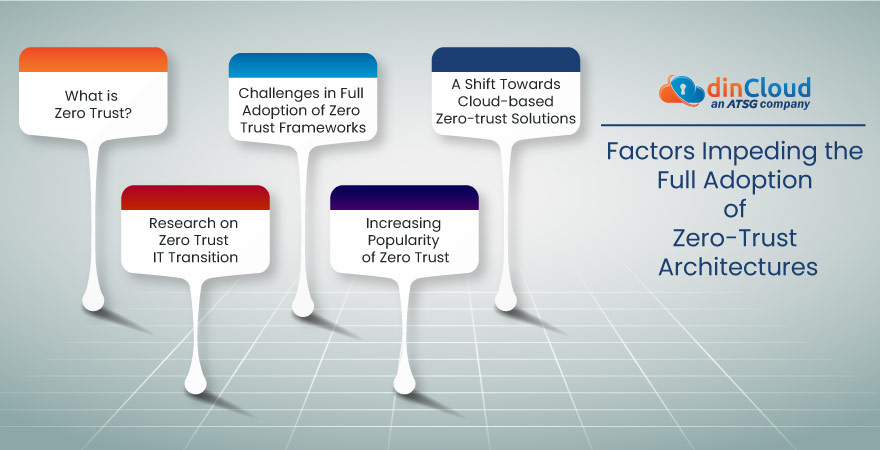Enterprises invest a lot of capital and resources to build trust with all their stakeholders. Development of this trust is vital, but when it comes to giving access to their IT resources and networks, organizations restrict this trust. The purpose here is to thwart cyber miscreants from menacing their IT infrastructures.
As the Covid-19 pandemic created a sudden need to work from home (WFH), very few organizations were actually prepared for the immediate shift to remote-based work. Even a little slackness in managing this shift in the workplace could prove extremely damaging for enterprise IT environments.

Cybersecurity became a grave concern for enterprises, and they were forced to adopt the “never trust, always verify” approach, which is manifested in Zero Trust security frameworks.
What is Zero Trust?
Zero Trust can essentially be summed up in the following principles:-
- Absolutely no user or device should be perpetually trusted, whether they are inside or outside the confines of the core enterprise network.
- Users should only be given access to the required resources that are necessary for getting the job done and nothing beyond that.
- Do not trust anyone and always validate, verify and secure all interactions in the digital landscape to reduce the impact of any possible security breaches.
Research on Zero Trust IT Transition
On behalf of Banyan Security, Sapio Research conducted a survey of 400 top-level decision makers from medium to large-sized U.S. and Canadian originations, regarding the Zero-trust IT transition. The results paint an interesting picture of the mindset of today’s enterprises.
97% of the key decision makers admitted that even though the deployment of the Zero-trust model is at the top of their priority list, 90% of them are still relying on legacy tools like Virtual Private Networks (VPNs).
44% of the respondents said they were in the early stages of adopting zero-trust architecture. More than half of them reported that they have already started the process of incorporating zero-trust solutions across their IT infrastructures.
Challenges in Full Adoption of Zero Trust Frameworks
Currently, secure remote access is unfortunately not a priority for 46% of the organizations. Chief Security Officer of Banyan Security, Den Jones, expressed his opinion regarding the survey that some organizations are still not ready to move away from VPNs, even though they are aware that a VPN does not usually offer application-level access control and robust security capabilities.
The budget constraint was another important factor (62%) that impeded the adoption of Zero-trust Network Access (ZTNA) solutions. 30% of the respondents were of the view that ZTNA solutions will not be compatible with their current IT/ environments. They were worried that the deployment of these solutions would be costly for their enterprise.
Even though vulnerabilities of VPN solutions are not hidden from anyone, some cybersecurity specialists are still of the opinion that the switch to ZTNA would be hard for many legacy applications and servers, which might not be able to adapt to this latest approach.
This approach is a good example of shortsightedness, as investments made in the adoption of Zero-trust architectures will actually be extremely beneficial for the future of an enterprise’s IT operations.
The amount of money spent on the recovery of IT resources impacted by cybersecurity vulnerabilities will be much higher as compared to the amount spent on the deployment of Zero Trust architectures.
Related Posts:
- Why Zero Trust Security Strategy is Future for Businesses
- The Pivotal Role of Zero Trust in Cloud Security
- Significance of Zero Trust Security in the Multi-Cloud
- Zero Trust Security – An Effective Risk Mitigation Model
Increasing Popularity of Zero Trust
There are multiple factors that can be attributed to the increased popularity of Zero-trust solutions in modern workplaces. 48% of the respondents said that secure remote access was the most important reason for this shift.
34% of the organizations reported that they adopted Zero Trust to improve end-user experience, while another 34% said that they deployed Zero-trust solutions because they reduced exposure to vulnerabilities created by VPNs and other legacy remote access solutions.
A Shift Towards Cloud-based Zero-trust Solutions
There is an ongoing debate about whether to deploy software for the implementation of zero-trust solutions, as-a-service, or should it be implemented by the lockdown of the hardware.
The survey also suggested that lack of expertise and certain confusion regarding the implementation of zero-trust solutions have forced enterprises to shift towards Cloud Service Providers (CSP) for the deployment of zero-trust security solutions, as a service. Jones added that most organizations have no knowledge about the number of security layers required to constitute a successful zero-trust model.
These days, end-users are not willing to sacrifice their application experience. Enterprise IT teams usually find it hard to figure out a way to successfully achieve this tall order, while keeping security intact. The deployment of Cloud-based zero-trust solutions has been more successful because on-premise solutions often lack the expertise of professionals that are dedicated to the improvement of the cyber-security posture of an enterprise.
Another advantage of deploying Cloud-based Zero-trust solutions is that end-users can check the cybersecurity posture of all their IT resources from any place, provided they have endpoint devices with an internet connection.
Conclusion
Zero Trust solutions definitely score more than traditional VPN solutions, as they depict an evolution in the security of online identities and devices. If we look beyond the hype created around Zero-trust and dig a little deeper, we will realize that they are actually worth the big switch.
For some reason, if the full-blown switch to Zero-trust architecture is not possible, even small steps taken in the right direction, coupled with a change in organizational culture can pay dividends in the form of a much-improved cybersecurity posture across the enterprise.
Contact dinCloud, an ATSG company, which has talented Cloud Computing experts to develop highly secure Cloud environments for your enterprise, at the fraction of the cost of on-premise solutions.


